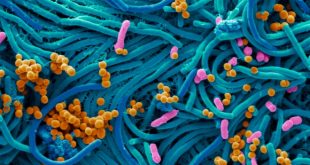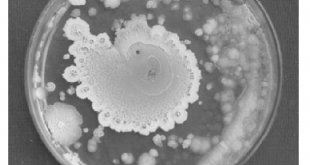
The Debate over Spontaneous Generation after Van Leeuwenhoek discovered the previously “invisible” world of microorganisms, the scientific community of the time became interested in the origins of these tiny living things. Until the second half of the nineteenth century, many scientists and philosophers believed that some forms of life could arise spontaneously from nonliving matter; they called this hypothetical process spontaneous generation. Not much more than 100 years ago, people commonly believed that toads, snakes, and mice could be born of moist soil; that flies could emerge from manure; and that maggots (which we now know are the larvae of flies) could arise from decaying corpses.
A strong opponent of spontaneous generation, the Italian physician Francesco Redi set out in 1668 to demonstrate that maggots did not arise spontaneously from decaying meat. Redi filled two jars with decaying meat. The first was left unsealed; the flies laid their eggs on the meat, and the eggs developed into larvae. The second jar was sealed, and because the flies could not lay their eggs on the meat, no maggots appeared. Still, Redi’s antagonists were not convinced; they claimed that fresh air was needed for spontaneous generation. So Redi set up a second experiment, in which he covered a jar with a fine net instead of sealing it. No larvae appeared in the gauze-covered jar, even though air was present. Maggots appeared only when flies were allowed to leave their eggs on the meat.
Best safe and secure cloud storage with password protection
Get Envato Elements, Prime Video, Hotstar and Netflix For Free
Best Money Earning Website 100$ Day
#1 Top ranking article submission website

Redi’s results were a serious blow to the long-held belief that large forms of life could arise from nonlife. However, many scientists still believed that small organisms, such as Van Leeuwenhoek’s “animalcules,” were simple enough to be generated from nonliving materials.
The case for spontaneous generation of microorganisms sound to be strengthened in 1745, when John Needham, an Englishman found that even after he heated nutrient fluids (chicken broth and corn broth) before pouring them into covered flasks, the cooled solutions were soon teeming with microorganisms. Needham claimed that microbes developed spontaneously from the fluids.

Twenty years later, Lazzaro Spallanzani, an Italian scientist suggested that microorganisms from the air probably had entered Needham’s solutions after they were boiled. Spallanzani showed that nutrient fluids heated after being sealed in a flask did not develop microbial growth, Needham responded by claiming the “vital force” necessary for spontaneous generation had been destroyed by the heat and was kept out of the flasks by the seals.
This intangible “vital force” was given all the more credence shortly after Spallanzani’s experiment, when Anton Laurent Lavoisier showed the importance of oxygen to life. Spallanzani’s observations were criticized on the grounds that there was not enough oxygen in the sealed flasks to support microbial life.

The issue was still unresolved in 1858, when the German scientist Rudolf Virchow challenged the case for spontaneous generation with the concept of biogenesis, the claim that living cells can arise only from preexisting living cells. Because he could offer no scientific proof, arguments about spontaneous generation continued until 1861, when the issue was finally resolved by the French scientist Louis Pasteur.
With a series of ingenious and persuasive experiments, Pasteur demonstrated that microorganisms are present in the air and can contaminate sterile solutions. But that air itself does not create microbes. He filled several short-necked flasks with beef broth and then boiled their contents. Some were then left open and allowed to cool. In a few days, these flasks were found to be contaminated with microbes. The other flasks, sealed after boiling, were free of microorganisms. From these results, Pasteur reasoned that microbes in the air were the agents responsible for contaminating nonliving matter.
Pasteur next placed broth in open-ended long-necked flasks and bent the necks into S-shaped curves. The contents of these flasks were then boiled and cooled. The broth in the flasks did not decay and showed no signs of life, even after months. Pasteur’s unique design allowed air to pass into the flask. but the curved neck trapped any airborne microorganisms that might contaminate the broth (Some of these original vessels are still on display at the Pasteur Institute in Paris).

Pasteur showed that microorganisms can be present in nonliving matter-on solids, in liquids, and in the air. Furthermore, he demonstrated conclusively that microbial life can be destroyed by heat and that methods can be devised to block the access of airborne microorganisms to nutrient environments. These discoveries form the basis of aseptic techniques, techniques that prevent contamination by unwanted microorganisms. which are now the standard practice in laboratory and many medical procedures. Modern aseptic techniques are among the first and most important concepts that a beginning microbiologist learns.
Pasteur’s work provided evidence that microorganisms cannot originate from mystical forces present in nonliving materials. Rather, any appearance of “spontaneous” life in nonliving solutions can be attributed to microorganisms that were already present in the air or in the fluids themselves. Scientists now believe that a form of spontaneous generation probably did occur on the primitive Earth when life first began, but they agree that this does not happen under today’s environmental conditions.
Revised by
- Abdul Bari Chowdhury on August 19, 2021
 Plantlet The Blogging Platform of Department of Botany, University of Dhaka
Plantlet The Blogging Platform of Department of Botany, University of Dhaka





